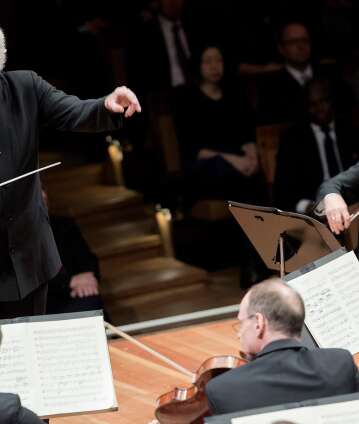Simon Rattle conducts Beethoven’s Symphonies Nos. 2 and 5

Beethoven’s Symphony No. 2 was composed at a time when the composer was expressing despondency about his increasing deafness in the famous Heiligenstadt Testament. Here too, the cheerfulness of the work keeps collapsing into an expression of shimmering agitation. In the Fifth Symphony, in contrast, we encounter a different Beethoven who addresses his destiny with forceful determination, all the way to the Finale that is sure of victory.
In Beethoven’s Second Symphony in D major, anything playful or cheerful is banned from the musical vocabulary, substituted for by the pathos later described with terms like “greatness” and “majesty”. No wonder the critic from the Allgemeinen musikalischen Zeitung wrote of a “colossal work” whose Finale, a veritable tour de force, ends in a thrilling stretta coda, ensuring a resplendent apotheotic conclusion.
In his Fifth Symphony, which Sir Simon Rattle has placed on the second half of this programme within his Beethoven cycle, Beethoven again drew on the idioms of French revolution music that he had used in the funeral march of the Eroica. Accordingly, the orchestral instrumentation, expanded in the Finale to include for the first time three trombones, piccolo and contrabassoon, approaches the instruments used in ceremonial martial music. In addition, there are many thematic references to the music of the French Revolution, which is why Robert Schumann pointed out the similarity with the First Symphony in G minor by Étienne-Nicolas Méhul, composed at the same time.
The famous “knocking motive” of the first movement seems to be taken, on the other hand, from Luigi Cherubini’s Hymne du Panthéon: the corresponding passage from the chorus, performed as the official music of the French Revolution in 1792, is about pledging to die for the republic and human rights.
This credo of liberté, égalité and fraternité also determines the opera Leonore or rather Fidelio, as in Beethoven’s interpretation Jean-Nicolas Bouilly’s originally politically unobjectionable libretto shifted into the revolutionary. In total he composed four overtures to the various versions of the opera; the Leonore Overture No. 1 in C major op. 138 was the third. All Leonore overtures document the attempt to capture in compressed form the action on stage in sound, resulting in an impressive concentration of motives and harmonic developments.
© 2015 Berlin Phil Media GmbH
Artists
Our recommendations
- Simon Rattle conducts “Russian rhythms” at the Waldbühne
- Simon Rattle and Magdalena Kožená at the Waldbühne
- Simon Rattle conducts Mahler’s Second Symphony
- Symphonic pictures with Sir Simon Rattle
- Europakonzert 2011 from Madrid with Simon Rattle and Cañizares
- Murray Perahia and Simon Rattle with Schumann’s Piano Concerto